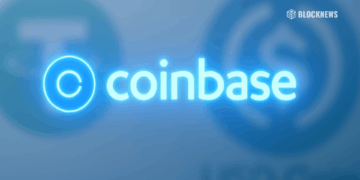- JPMorgan has launched JPMD, a permissioned “deposit token” on Coinbase’s Base blockchain, giving institutional clients on-chain access to actual bank deposits with 24/7 settlement and potential interest payments.
- Unlike public stablecoins such as USDT and USDC, JPMD is tightly integrated with the traditional banking system, restricted to vetted institutions, and designed to move cash faster while staying inside existing regulatory and banking rails.
- Early interest from large institutions and a broad JPMD trademark (covering trading, transfers, and payments) signals how Wall Street is starting to use public blockchains for real money movement—just on its own controlled terms.
JPMorgan Chase is dipping even deeper into crypto, but in a very JPMorgan kind of way. The U.S. banking giant has unveiled its own stablecoin-style token called JPMD, a digital deposit token that lives on Coinbase’s Base blockchain, which itself is built on top of Ethereum.
Instead of launching a public stablecoin like USDT or USDC, JPMorgan is going with something more controlled: a token that represents actual commercial bank deposits, wrapped in blockchain form. Think of it as your regular bank balance — just moving around on-chain instead of through the clunky legacy rails.
What exactly is JPMD?
JPMD is what’s known as a deposit token. Each token is a digital representation of a real deposit sitting inside JPMorgan’s traditional banking system. It’s not a random crypto asset floating in the wild; it’s tied to fiat deposits, with the bank firmly in the loop.
A few key points:
- It will live on Base, Coinbase’s public Ethereum Layer 2 network.
- It’s designed to offer 24/7 settlement, unlike standard bank transfers that sleep on weekends and holidays.
- It can be interest-bearing, meaning JPMorgan can pay interest to holders of JPMD, just like they would with regular deposit products.
There’s one big catch though:
JPMD isn’t for you and me. It’s a permissioned token, restricted to JPMorgan’s institutional clients only. No retail degen farming yields with JPMD on some random DEX.
Naveen Mallela, global co-head of Kinexys, the bank’s blockchain arm, told CNBC they expect institutions to use JPMD for things like:
- On-chain settlement of digital assets
- Cross-border B2B transactions
- Faster, more flexible movement of cash between large entities
He also pointed out that since deposit tokens can be interest-bearing, they’re more “fungible” with existing deposit products. In other words, institutions don’t have to mentally separate “bank money” from “blockchain money” — it’s the same thing, just in a new wrapper.

Deposit token vs. stablecoin: what’s the real difference?
On the surface, deposit tokens and stablecoins kind of look alike. Both are digital tokens that aim to mirror the value of fiat currency, usually 1:1 with the dollar. But structurally, they come from different worlds.
Stablecoins like USDT (Tether) and USDC (Circle) are typically issued by crypto-native companies. They’re backed by reserves (in theory) and circulate publicly on various blockchains. Anyone with a wallet can hold or move them. The total stablecoin market is sitting around the hundreds of billions mark, and it’s become the core liquidity backbone of the crypto space.
Deposit tokens like JPMD, on the other hand:
- Are issued by a regulated bank, not a pure crypto company.
- Represent actual bank deposits, sitting inside the traditional financial system.
- Are permissioned and limited to vetted institutional users, not the general public.
JPMorgan’s pitch is simple: a deposit token gives big clients the speed and programmability of crypto, without forcing them to leave the comfort (and regulatory clarity) of the banking system.
Meanwhile, stablecoins in the U.S. are still in a bit of a gray zone. Regulation is coming — with things like the GENIUS Act on the table and MiCA already live in the EU — but for now, the framework isn’t fully locked in. That makes deposit tokens an appealing alternative for risk-averse institutions that want something “crypto-ish,” but not too wild.
Why launch it on Coinbase’s Base?
A lot of people were surprised JPMorgan chose Base as the home for JPMD. The bank’s digital asset chief told CNBC that Coinbase was already a long-standing client and a leader in the crypto space, making it a natural partner.
Choosing Base also sends a pretty clear message: this isn’t some private, closed JP-only chain experiment. It’s a public blockchain integration, just with a permissioned asset sitting on top.
Mallela mentioned that there’s already “preliminary interest” from large institutional players who want more native on-chain cash solutions from big, reputable financial institutions. In other words, there’s demand from big money to move real dollars across public chains — but with banks in the driver’s seat.
The trademark hints and the stablecoin rumors
Before the official reveal, the internet was already buzzing. A trademark filing for “JPMD” went public on Monday, outlining a wide range of digital asset services:
- Trading
- Exchange
- Transfers
- Payments
Crypto media quickly started guessing that JPMorgan might be launching a full-blown stablecoin. Given how long the industry has speculated about “JPM Coin 2.0,” it wasn’t a crazy leap.
But now the bank is setting the record straight:
- Yes, JPMD shares some similarities with a stablecoin.
- No, it’s not exactly the same thing.
- It’s a deposit token — a product designed specifically for institutions, deeply tied into core banking, rather than a free-floating dollar token for everyone.
Why this matters (even if you’ll never hold JPMD)
Most retail users will never touch JPMD directly. But it still matters a lot. It shows where the next phase of crypto adoption is heading:
- Public blockchains like Ethereum and Base
- Big banks issuing on-chain cash instruments
- TradFi and DeFi slowly blending, but under strict permissioned models
JPMD is basically a signal that the line between “crypto infrastructure” and “traditional banking” is getting thinner. You might still be trading memecoins on one side, but somewhere in the background, the largest bank in the U.S. will be settling institutional transactions on the same base technology — just with stricter access and very familiar logos.
Not quite a stablecoin. Not just another token. More like a trial run for how Wall Street wants money to move on-chain — on its own terms.














